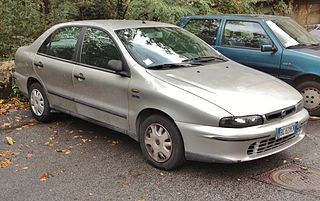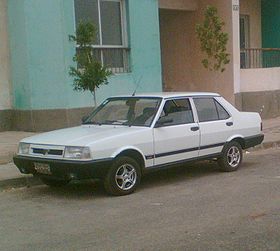
The Fiat 128 is a transverse front-engine, front wheel drive small family car manufactured and marketed by Fiat from 1969 to 1985 as a two- or four-door sedan, three- or five-door station wagon as well as two- or three-door coupé. The 128 running gear and engine, reconfigured for a mid-engined layout, were used in the Fiat X1/9 sports car.

The Fiat 124 is a small family car manufactured and marketed by Italian company Fiat between 1966 and 1974. The saloon superseded the Fiat 1300 and spawned station wagon, four-seater coupé, and two-seater convertible variants.

The Fiat Tipo is a compact car, designed by the I.DE.A Institute design house, and produced by the Italian manufacturer Fiat between 1988 and 1995.

The Fiat Tempra is a small family car produced by the Italian automaker Fiat from 1990 to 1996 in Italy. The Tempra was intended as a replacement for the Fiat Regata. The original project was called Tipo 3, being a mid-size car between the Fiat Tipo and the bigger Fiat Croma. The Tempra shares its Type Three platform with the Lancia Dedra and Alfa Romeo 155.

The Subaru Rex, also known as Ace, Viki, Sherpa, 500/600/700, Mini Jumbo, Mini Subaru or M60/M70/M80 in various export markets, is a kei class automobile produced from 1972 to 1992 mainly for sale in Japan by Subaru, although it was also sold in Europe, South America, Australia and the Caribbean. The Rex superseded the R-2 as Subaru's kei car, and has been available in commercial use versions as well as in a passenger car version. It underwent major changes in 1976, in fall 1981, and again in late 1986. The second generation Rex (1981–1986) also formed the basis for the larger Subaru Justy.

The Fiat 131 is a family car manufactured and marketed by Fiat from 1974 to 1984 after its debut at the 1974 Turin Motor Show. Available as a two-door and four-door saloon and 5-door estate across a single generation, the 131 succeeded the Fiat 124.

The Fiat 1100 is a small family car produced from 1953 until 1969 by the Italian manufacturer Fiat. It was an all-new unibody replacement for the Fiat 1100 E, which descended from the pre-war, body-on-frame Fiat 508 C Balilla 1100. The 1100 was changed steadily and gradually until being replaced by the new Fiat 128 in 1969. There were also a series of light commercial versions of the 1100 built, with later models called the Fiat 1100T, which remained in production until 1971. The Fiat 1100 D also found a long life in India, where Premier Automobiles continued to build the car until the end of 2000.

The Fiat Doblò is a panel van and leisure activity vehicle produced by Italian automaker Fiat since 2000. It was unveiled at the Paris Motor Show in October 2000. A second-generation Doblò succeeded the original vehicle in 2010 for most markets, and it was sold in the United States as the RAM ProMaster City from 2015 to 2022. The second generation was also sold in Europe and the UK as the Opel/Vauxhall Combo. The third-generation Doblò, a rebadged version of the Citroën Berlingo, was unveiled in June 2022, and is also sold as the Opel or Vauxhall Combo, Peugeot Partner, and Toyota ProAce.

The Fiat Marea is a small family car available as a saloon and an estate, produced by the Italian automaker Fiat. Launched in September 1996, the Marea models were essentially different body styles of Fiat's hatchback offerings, the Bravo and Brava. The Marea replaced the earlier Tipo based Fiat Tempra, as well as the larger Croma.

The Fiat 147 was a three-door hatchback subcompact car produced by Fiat in the Brazilian state of Minas Gerais from autumn 1976 until 1987, when it was replaced by the Fiat Uno. It was the Brazilian variant of the Fiat 127. Some were also built by Sevel in Argentina until 1996, and assembly also took place in Colombia, Uruguay and Venezuela.

The Toyota Wish is an automobile produced by the Japanese automaker Toyota from 2003 to 2017. It is a compact MPV with standard three-row seating, and was positioned between the Corolla Spacio and the Ipsum in Toyota's minivan lineup. In Japan, it was available at Toyota Netz dealerships.

The FSO Polonez is a motor vehicle that was developed in Poland in collaboration with Fiat and produced by Fabryka Samochodów Osobowych from 1978 to 2002. It was based on the Polski Fiat 125p platform with a new hatchback design by Zbigniew Watson, Walter de Silva and Giorgetto Giugiaro. It was available in body styles that included two- and four-door compact-sized cars, station wagons, as well as commercial versions as pickup truck, cargo van, and ambulance. Production totaled more than one million units, excluding the pickup truck and van variants. The Polonez was marketed in other nations and was popular in its domestic market until Poland joined the European Union in 2004.

The Fiat Fiorino is a small commercial vehicle produced by the Italian car manufacturer Fiat since 1977. Its first two generations have been the panel van derivatives of other small models, such as the Fiat 127 and Fiat Uno, while the current third generation was developed jointly with PSA Peugeot Citroën, and is based on the Fiat Small platform.

The Maserati Biturbo is a family of executive grand tourers produced by Italian automobile manufacturer Maserati between 1981 and 1994. The original Biturbo was a two-door, four-seater notchback coupé featuring, as the name implies, a two-litre V6 engine with two turbochargers and a luxurious interior.

Tofaş is a Turkish automobile manufacturer which was established in 1968 by Vehbi Koç, who was the founder of Koç Holding, based in Bursa, where the manufacturing plant of the company is located. It is jointly owned by Stellantis and Koç Holding.
Nasr is Egypt's state owned automobile company. It is the first Arab vehicle manufacturer, founded in 1960 in Helwan, Egypt. Since, the company has produced licensed versions of the Fiat 1100 R, Fiat 1300, Fiat 2300, Fiat 128, Fiat 125, Fiat 133, Fiat 126, series 2 Fiat 127, 1983–92 FSO Polonez and in 1991 introduced a further range of Fiat-designed cars licensed via the Turkish company Tofaş. In the early 2000s Nasr began producing the Florida range under license from Serbian manufacturer Zastava.

The Suzuki Mighty Boy is an automobile which was produced by Japanese automaker Suzuki from 1983 to 1988. It was the only "bonnet type" pick up ever sold in the 550 cc era of the Kei class. It was classified as a commercial vehicle in Japan so as to benefit from lower taxes for such vehicles, but its utilitarian values were certainly restricted. While the Mighty Boy was not a runaway success and was never replaced in the Suzuki lineup, the car still has a dedicated following in Japan.

The Fiat Linea is a compact sedan produced by Fiat between 2007 and 2018. The sedan was released on 26 March 2007 at the Tofaş plant in Bursa, Turkey as a "world car" in developing countries. It is based on the Fiat Grande Punto. The Linea was designed by Fiat Style Centre and co-developed by Tofaş and Fiat do Brasil. Production in Turkey ended in 2016.

The eighth-generation Honda Civic is a range of compact cars (C-segment) manufactured by Honda between 2005 and 2012, replacing the seventh-generation Civic. Four body styles were introduced throughout its production run, which are sedan, coupe, and both three-door and five-door hatchback. The sedan version was introduced with two distinct styling for different markets, with one of them sold as the Acura CSX in Canada and as the Ciimo 1.8 in China from 2012 until 2016. The hatchback versions formed the European-market Civic range, which received a different architecture, body design and smaller footprint, and solely produced in Swindon, United Kingdom.

The Tofaş Museum of Cars and Anatolian Carriages is a private transport museum in Bursa, Turkey owned by the Turkish automobile maker Tofaş and dedicated to various carriages from Turkey and Tofaş-manufactured cars. It was opened on June 30, 2002.
























